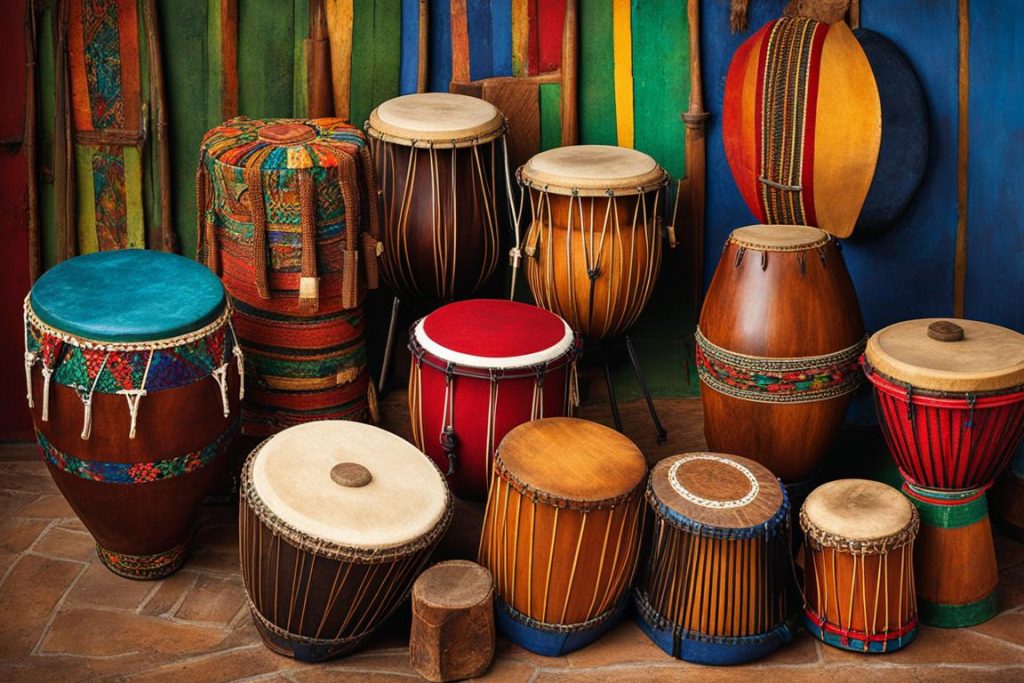Looking to add some rhythm and excitement to your music? Look no further than percussion instruments that you shake!
Percussion instruments are a key component of any musical ensemble, providing the rhythmic foundation and adding texture to the overall sound.
In this comprehensive guide, we will explore the best instruments that you can shake to create mesmerizing beats and captivating rhythms.
When it comes to shaking instruments, there is a wide variety to choose from. From traditional maracas and tambourines to unique shaker bags and cabasas, there is something for everyone’s musical taste.

These handheld instruments are perfect for both beginners and seasoned musicians, allowing you to easily create complex rhythms and grooves.
Whether you are looking for percussion instruments that you can use in a band, solo performances, or even just to add some fun to your jam sessions, this guide has got you covered.
We will dive into the history of percussion instruments, explore the different types available, and take a closer look at their role in various musical genres.
So get ready to shake things up! Let’s explore the fascinating world of percussion instruments and discover the rhythmic possibilities they offer.
Whether you are a drummer, a percussionist, or simply a music enthusiast, you’ll find plenty of inspiration and information in this percussion guide.
Content
Percussion Instruments: What are They?
Percussion instruments encompass any instrument that you hit, shake, or scrape to produce sound.
The word “percussion” comes from the Latin “percussionem,” which means to strike or blow.
These instruments are essential for creating rhythm in music and can be categorized into two main types: membranophone instruments and idiophone instruments.
Membranophone Instruments
Membranophone instruments are percussion instruments that produce sound through a vibrating membrane.
The most common example of a membranophone instrument is the drum. When the drumhead is struck, it vibrates and produces sound.
Timpani, snare drums, and bass drums are all examples of membranophone instruments.
Idiophone Instruments
Idiophone instruments are percussion instruments that produce sound through the vibrations of the instrument itself.
Cymbals and castanets are examples of idiophone instruments. When struck together or against another surface, they create a distinct sound. Other idiophone instruments include xylophones, triangles, and tambourines.
Percussion instruments play a vital role in various music genres, from classical orchestras to modern bands. They provide rhythm, texture, and impact to musical compositions.
Whether it’s the pounding beat of a bass drum or the shimmering sound of a triangle, percussion instruments add depth and excitement to music.
A Brief History of Percussion Instruments
Percussion instruments have a rich history that spans thousands of years, making them one of the oldest types of instruments in existence.
They were present in various ancient civilizations, including the Mesopotamian, Egyptian, Greek, and Roman empires.
Drums, in particular, have been used in almost all cultures and hold significant cultural and spiritual significance.
Throughout history, percussion instruments have evolved and diversified to meet the needs and preferences of different societies and musical styles.
From simple handheld drums made from animal skins to complex orchestral percussion instruments, the evolution of percussion has been fascinating to witness.
Recently, percussion instruments like the drum kit and electronic drums have emerged and gained popularity in modern music genres.
The drum kit, consisting of various drums and cymbals played with drumsticks, revolutionized the rhythm sections of bands and brought percussion instruments to the forefront of contemporary music.
The image above provides a visual representation of the evolution of percussion instruments, showcasing the transformation from primitive drums to modern electronic drums.
European and US Percussion Instruments
European and US percussion instruments encompass a wide range of instruments used in orchestras and popular music.
These instruments that you shake play a vital role in creating rhythm and adding depth to musical compositions.
From the powerful beats of drums to the shimmering tones of cymbals, percussion instruments contribute to the overall sound and vibe of a performance.
One of the most iconic percussion instruments is the drum kit. Consisting of various drums, cymbals, and other accessories, the drum kit forms the backbone of many musical ensembles.
It includes instruments such as the snare drum, bass drum, and cymbals, which are essential components in modern music.
The snare drum, played with drumsticks, creates a sharp, crisp sound that cuts through the music, providing a rhythmic foundation.
The bass drum, on the other hand, produces a low, booming sound that adds depth and impact to the overall composition.
Cymbals, including crash cymbals and ride cymbals, provide a shimmering, sustained sound that adds texture and accents to the music.
Aside from the drum kit, other European and US percussion instruments commonly used in classical and contemporary music include the triangle and glockenspiel.
The triangle, a simple instrument made of metal, produces a clear, bell-like sound when struck. It is often used to add a sparkling, high-pitched element to musical pieces.
The glockenspiel, resembling a xylophone with metal bars, produces bright, bell-like tones that are used to create melodies or add color to orchestral arrangements.
In addition to drums and melodic percussion instruments, there are also handheld instruments like the tambourine and maracas that are widely used in European and US music.
The tambourine, often played by shaking or striking it, adds a lively, percussive sound to a musical performance. Maracas, on the other hand, are shaken to create a rattling sound that adds a rhythmic groove to the music.
Overall, European and US percussion instruments offer a wide array of sounds and textures that enhance musical compositions in various genres.
Whether in symphonies, rock bands, or jazz ensembles, these instruments play a crucial role in creating rhythm, accentuating melodies, and providing dynamic contrast.
Latin America and the Caribbean Percussion Instruments

Latin America and the Caribbean have a rich musical heritage that is deeply intertwined with the vibrant rhythms and infectious beats of percussion instruments.
From the lively streets of Cuba to the beaches of Brazil, the region is home to a diverse range of Latin American and Caribbean percussion instruments that have captivated audiences worldwide.
One of the most iconic and best instruments that you can shake are the maracas. These handheld instruments, originally made from gourds filled with seeds, create a distinct rattling sound that adds a playful and rhythmic element to the music.
Maracas are commonly used in genres such as salsa, samba, and merengue, infusing the music with a lively energy.
Another fascinating instrument is the shekere, which originates from West Africa but has found its way into the music of Latin America and the Caribbean.
Made from a gourd covered with a net of beads or shells, the shekere is played by shaking, striking, or twisting it, producing a unique combination of rattling and percussive sounds.
It plays an integral role in genres like Afro-Cuban music and adds a captivating texture to the music.
The cabasa is yet another percussion instrument that has gained popularity in the region.
It consists of a cylinder made of wooden beads wrapped around a metal cylinder, which is played by rubbing a stick or hand against the beads, creating a distinctive sound that resembles the shaking of maracas.
The cabasa is commonly used in Latin jazz and other Latin American music genres, providing a rich and rhythmic foundation.
Without mentioning the tambourine, no discussion of Latin American and Caribbean percussion instruments would be complete.
This handheld instrument, consisting of a circular frame with jingles, is played by striking or shaking it to produce a shimmering sound that cuts through the music.
The tambourine is a staple in various musical styles, including calypso, reggae, and Latin folk music, adding a lively and festive quality.
Other percussion instruments like the gong and chimes also contribute to the diverse tapestry of Latin American and Caribbean music.
The gong, with its deep and resonant sound, is often used in ceremonial and religious music, while the chimes create a delicate and melodic backdrop in various musical settings.
| Percussion Instrument | Origin | Characteristics |
|---|---|---|
| Maracas | Latin America | Handheld instruments made from gourds, producing a rattling sound. |
| Shekere | West Africa (adopted by Latin America and the Caribbean) | A gourd covered with a net of beads or shells, played by shaking, striking, or twisting. |
| Cabasa | Latin America | A cylinder made of wooden beads wrapped around a metal cylinder, played by rubbing a stick or hand against the beads. |
| Tambourine | Multiple regions, including Latin America and the Caribbean | A circular frame with jingles that is struck or shaken to produce a shimmering sound. |
| Gong | Asia (adopted by Latin America and the Caribbean) | A large metal disc that produces a deep and resonant sound. |
| Chimes | Multiple regions, including Latin America and the Caribbean | Rows of tuned metal tubes or rods that create melodic tones when struck. |
Handheld Percussion Instruments
Are you looking for versatile and portable percussion instruments to add excitement and texture to your musical performances?
Look no further than handheld percussion instruments.
These instruments are perfect for solo acts, band performances, or drum circles, allowing you to create a variety of rhythmic and percussive effects.
There are several types of handheld percussion instruments that you can explore:
- Maracas: Maracas are small handheld shakers that produce a shaking sound when you move them back and forth. They are commonly used in Latin American music and add a vibrant and rhythmic texture to the music.
- Shaker Bags: Shaker bags are versatile percussion instruments that consist of several small shakers enclosed in a fabric pouch. They produce a variety of shaking sounds and can be easily manipulated with your hands, allowing for rhythmic variations.
- Egg Shakers: Egg shakers are small handheld percussive instruments shaped like eggs, filled with small beads or pellets. They are lightweight yet produce a pronounced shaking sound. They are commonly used in various genres of music, including folk, pop, and rock.
- Tambourines: Tambourines are handheld percussion instruments that combine the elements of shaking and striking. They consist of a circular frame with small metal jingles (called zils) attached to it. By shaking and striking the tambourine, you can create a jingling sound that adds a vibrant, rhythmic accompaniment to the music.
- Shekeres: Shekeres are handheld percussion instruments originating from West Africa. They consist of a gourd or a hollow sphere covered with a net of beads, shells, or seeds. By shaking, striking, or twisting the shekere, you can create a variety of rhythmic patterns and textures.
Next time you want to infuse your musical performance with rhythm and excitement, consider using handheld percussion instruments.
Their portability and versatility make them a valuable addition to any musician’s toolkit.
Percussion Instruments in the Orchestra
Percussion instruments play a crucial role in the orchestra, providing rhythm, texture, and color to the overall sound. From the majestic timpani to the tinkling triangle, each instrument brings a unique flavor to the musical composition.
The timpani, also known as kettle drums, are large drums with a deep, resonant sound. They add a powerful and dramatic element to orchestral pieces. The xylophone, on the other hand, produces bright and vibrant tones, adding a touch of sparkle to the music.
Cymbals, with their shimmering and crashing sounds, create thrilling accents and climactic moments in the orchestra.
The triangle, seemingly simple in design, can add delicate and ethereal chimes to the overall composition.
The snare drum and bass drum provide the foundation for the orchestral rhythm. The snare drum offers crisp and lively beats, while the bass drum provides deep and thunderous sounds.
For me, the best instruments that you can shake are Tambourines and maracas which bring a touch of rhythmic energy and playfulness to the orchestra.
